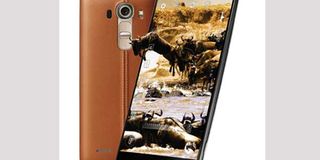The changing face of phone photography

The LG G4 smartphone. LG has pioneered to bring top notch photography to android with a 16 megapixel rear camera with its laser and aperture technology fit for the professional photographer. PHOTO | COURTESY
What you need to know:
Now, cameras cannot only recognise surrounding sceneries but can also make the necessary adjustments to the camera settings.
Artificial Intelligence in cameras is not just about scene recognition.
It works on several fronts such as edge detection in portraits, face recognition, enhancing colour of the images, smoothing skin, among many others.
Since the late 1990s, phone cameras have undergone a revolution. Gone are the days of having to wait until rolls of film are developed into negatives and then printed to photographs. When the first cameras showed up in cell phones, the images they captured were jaded: Grainy and of poor quality at best.
LEADING FEATURES
Today there are very few phones that don’t come equipped with cameras. Some have cameras that put to shame the traditional cameras that predated phones. In a few short years, the technology behind these cameras has grown by leaps and bounds.
The stigma, at least surrounding mobile phone photography, has all but disappeared, except for the most fervent traditionalists who still tag along with the conventional camera. The line between mobile devices and conventional cameras has blurred so much that we no longer question why someone uses their phone to take a photo.
Today’s camera phones feature megapixels in the double digits. They are equipped with optical zoom, red-eye features, and the capability to shoot high definition video. The quality of a phone camera is one of the leading features that phone manufacturers tout when beating the sales drum.
IMPROVEMENTS
One of the most pronounced changes in the use of cameras is at social events. If you attend a social performance, you'll be confronted by a forest of arms holding cameras aloft. At a wedding ceremony, for example, hundreds of little cameras flash every so often.
Artificial intelligence or AI in phone camera give it human-like intelligence. The AI cameras are a rage among phone makers like Google, Huawei, and Samsung. Together, they've brought massive technological improvements to their phone cameras. Now, cameras cannot only recognise surrounding sceneries but can also make the necessary adjustments to the camera settings.
RECOGNITION
Artificial Intelligence in cameras is not just about scene recognition. It works on several fronts such as edge detection in portraits, face recognition, enhancing colour of the images, smoothing skin, among many others. It knows that it’s looking at a person, food, nature or animals. Subsequently, the AI camera chooses the most applicable exposure and colour adjustments for that perfect shot.
Ubiquitous digital cameras turn events that in themselves would be a small story into a worldwide phenomenon that ricochets the world in minutes. Before the camera phone became pervasive, video cameras could always be found at events where it was known in advance that something interesting was likely to happen. With camera phones, everyone has a video camera in their pocket.
UPPED GAME
While it’s true that most smartphones pack a decent camera nowadays, some camera phones shine so much brighter than the rest. The likes of Apple, Huawei, and Samsung have upped their game so much you could even ditch your dedicated camera and just use a phone, and you'd be hard-pressed to be able to tell the difference in the results.
Wambugu is an Informatician. E-mail: [email protected] @samwambugu2





